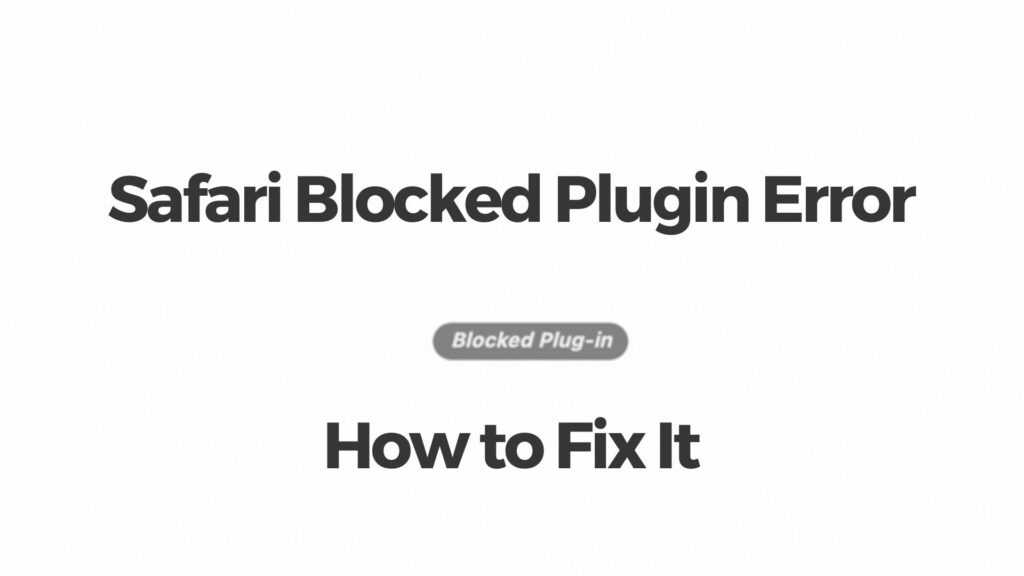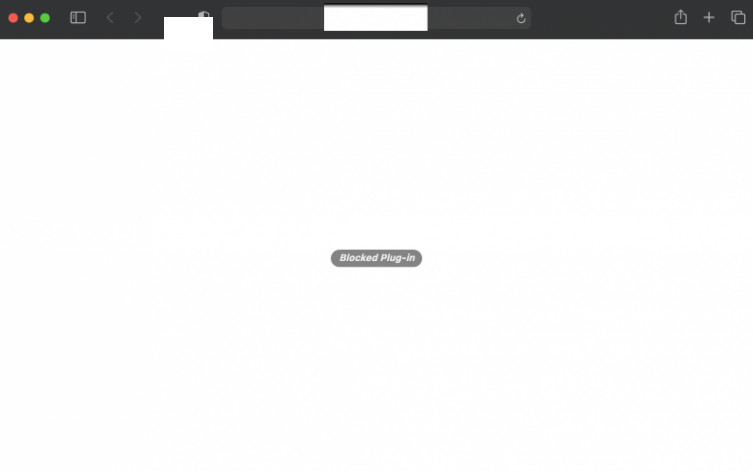What Is Blocked Plug-in Safari Error?
The blocked plug-in error occurs when Safari has blocked a plug-in on a website. This can happen when a plug-in is out of date, insecure, or not supported by the website. When this occurs, you may see a grey box in place of where the plug-in should be, or an error message may appear. To resolve this, you can update or enable the plug-in in Safari’s preferences.
Read this article to learn more about what might be causing this error, how to fix it and what to do if it cannot be fixed.

Blocked Plug-in Details
| Name | Blocked Plug-in |
| Type | Browser Error |
| Short Description | An error message on Safari, stating that a plugin is blocked. |
| Symptoms | Shows a browser page, stating a plug-in is blocked. |
| Program | Safari on Mac |
| Fix Tool |
Try this fix to repair your Mac from errors and optimise system performance: Download
SpyHunter
|
What Is Causing Blocked Plug-in Safari Error?
Blocked plug-in errors in Safari are caused when a plug-in, such as Adobe Flash, is out of date or unsupported. This can prevent websites from loading correctly, and can occur due to a misconfigured security setting or outdated software. To fix this error, the user needs to update the plug-in to the latest version, or disable it and try an alternative solution.

Even though less likely, other possible causes for this to appear on Safari may also be:
- Damaged or corrupted files on the external drive.
- A pending update of the operating system or safari.
- A malware-related problem.
Is Blocked Plug-in Mac Error Dangerous?
The blocked plugin Mac error can be a serious issue and should not be taken lightly. If left unaddressed, this error can lead to system instability, data loss, and other security risks. It is important to be proactive when dealing with this error and to take immediate measures to resolve the issue. This may include disabling any unnecessary plug-ins, updating your operating system, or using a malware removal tool.
Does Blocked Plug-in Safari Error Appear on PDF?
The blocked plug-in Safari error can appear on PDF files when a user attempts to open the file with Safari. This error indicates that the web browser does not have the necessary plug-in to view the PDF, and the user must install the plug-in to be able to view the PDF. The most common plug-ins used to view PDFs in Safari are Adobe Acrobat and Foxit Reader. Once the plug-in is installed, the user should be able to view the PDF without further problems.
How to Fix Blocked Plug-in Safari Error?
To fix this error, the most direct and quickest method would be to follow the manual steps below:
1. Open the Safari browser on your Mac.
2. Select the ‘Safari’ menu.
3. Select the ‘Preferences’ option from the menu.
4. Navigate to the ‘Security’ tab and click on it.
5. Uncheck the box that says ‘Enable plug-ins’.
6. Close the window.
7. Restart the Safari browser.
8. Check if the blocked plug-in error is fixed.
You can also select each plugin separately using these steps:
1. Open the Safari browser on your Mac.
2. Select the ‘Safari’ menu.
2. Choose ‘Websites’.
3. You will see a list of plugins. Simply choose the one you want and enable it.
Is Blocked Plug-in Safari Error a Virus?
No, the Blocked Plug-in Safari Error is not a virus. It is an error message that is caused when a plug-in or extension used by Safari is not compatible with the browser. This error can be resolved by either disabling the plug-in or updating it to a compatible version. Additionally, users can also reset their Safari browser to its default settings in order to resolve this error.
What If I Can’t Fix Blocked Plug-in Safari Error?
If you’re getting a blocked plug-in Safari error, don’t panic. There are a few things you can try to get your browser running again. First, try updating Safari and all of your plug-ins. If that doesn’t work, you can try disabling all plug-ins and then re-enabling them one-by-one to find the source of the problem. If all else fails, you can try resetting your browser settings and clearing your cache. If none of these solutions work, you may need to contact Apple Support for further assistance.
There is also the probability that this may be a problematic plugin or even malware for Mac. This is why if all else fails, we recommend trying the administrative repairs below.
Option 1. Run the dot_clean command in Terminal
- Open the Terminal application.
- Type the dot_clean command and hit the Return key.
- Drag the problematic folder that you failed to copy into the Terminal box. Once loaded, hit the Return key again.
- Once you’ve completed these actions, you can attempt to perform the same action again and see whether the error appears.
Option 2. Allow full access to the problematic file/folder
This solution will help you, if the error is related to your account lacking privileges to change the problematic folder or file. You can fix that by logging in your administrator account and changing the file property to allow full access to the said file/folder.
- Right-click the folder or file that triggered the Error Code -36.
- Select Get Info.
- Uncheck the Locked option under the General Tab.
- Go to Sharing & Permissions, and make sure your account has read and write permissions to the said file or folder.
Option 3. Use Disk Utility’s First Aid
Since this error is related to a hard drive, using the First Aid in Disk Utility may do the trick of fixing it. To do that, follow these steps:
- Open Finder and select Applications, then Utilities.
- Double-click Disk Utility to start it.
- From its sidebar, choose the hard drive that caused the error to appear.
- Click First Aid and wait for the repair process to finish.
This should have resolved the Mac Error Code -36. However, if the problem persists, continue with the last two options.
Option 4: Install the latest updates of your OS.
Go to System Preferences – Software Update and check whether a newer macOS version is available for download. You will see a button to install it and Upgrade, if it is available.
Option 5: Scan your computer for errors and optimise it automatically.
If you have tried most of the fixes, but you keep getting error messages, consider checking your Mac for:
- Malware and unwanted programs.
- Tracking cookies and other pesky and harmful objects.
- Adware.
- Browser Hijackers.
- Problematic files.
You can do all of this by running an automatic scan of your computer using a professional anti-malware program.
Spy Hunter scanner will only detect the problem. If you want the issue to be automatically removed, you need to purchase the full version of the anti-malware tool.Find Out More About SpyHunter Anti-Malware Tool / How to Uninstall SpyHunter
Mac Errors – Frequently Asked Questions
What are Mac Errors?
Mac errors are faulty problems of macOS. They are different types, affecting various programs running on your Mac.
Since macOS is frequently updated, it is easier to fix such errors, due to the way this operating system is constructed.
What Do Mac Error Codes Mean?
Error Codes on Mac are how your macOS explains the different types of problems that can occur on it. The number of the Mac Error code pops up on your screen, and it shows you the error with some explanatory text to help you fix it.
These error codes exist for both small and bigger problems, and in some cases, they can mean that there is a significant issue with your device.
Why Do I See Errors On My Mac?
The reasons may vary. These can be due to a badly written code, faulty software, external app modifying your app, incompatibility, problems with the resources required to run the app, and even a Mac malware infection.
What Types of Mac Errors Exist?
Just like with Windows devices, there are some general error types with Mac as well, including:
- Runtime Errors – when you execute a program and it fails due to badly written code, incompatibility with the program and web servers or other problems, like malware.
- Logic Errors – something in the logic makes the program fail to return results.
- Arithmetic Errors – a type of logic error, which involves miscalculation due to an erroneous configuration or code that does not fit the same logic as the system reads it.
- Resource Errors – when your device does not meet the resources required to run a program or if the program is coded faulty, so it requires more resources than necessary.
- Interface Errors – when there is a difference between what an app is meant to do and what it actually does.
- Compilation Errors – when the compiler of a software fails to turn complicated code into a simple language, understandable by your Mac.
Which are The Most Common Mac Errors?
According to different sources and online forums, the most commonly encountered errors on Mac carry the following codes:
- Error Code 36 – when Finder fails to read or write a file on your Mac.
- Error Code 41 – caused by malware, outdated software or corrupted files and directories.
- Error Code 50 – when you fail to copy and paste a file onto another drive, like USB or an external SSD or HDD.
- Error Code 2003F – it shows up when you try reinstalling your macOS in Recovery Mode. Possible causes include bad sectors in the hard disk, malware, etc.
What to Do If I See a Mac Error?
If you see an error on your Mac, your first job is to check the meaning of it. Then, you can see reputable forums, like Apple Discussions or SensorsTechForum in order to find different types of fixes for the problem.
How to Stop Getting Mac Errors?
You cannot. As long as there are people writing the code, there will always be the human error factor. However, there are several measures that you can take in order to significantly reduce the chance of getting a Mac Error:
- Check and update your Mac and your Apps (if possible) to the latest version on a daily basis.
- Install a relevant and reputable anti-malware for Mac.
- Install an optimizer for your Mac, which will keep all your apps updated, remove junk software, and improve your Mac’s health.
- Only install apps from trusted sources.













